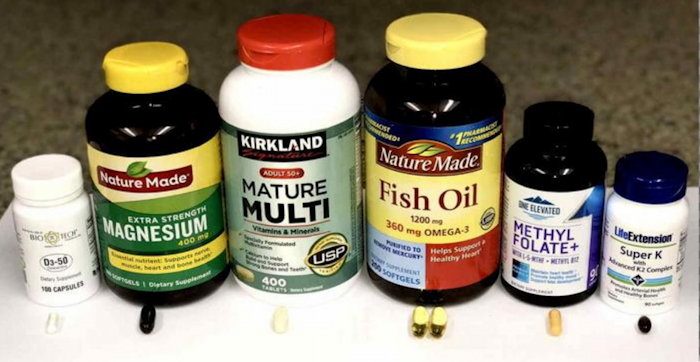-
Posts
4 -
Joined
-
Last visited
Posts posted by SECAuthentics
-
-
On 8/16/2020 at 12:37 AM, xxx said:
Hey SECAuthentics,
All of us on the anti-inflammatory regimen experience burnthrough CH at one time or another. The solution is simple. If you haven't switched to the Bio-Tech D3-50 50,000 IU water soluble vitamin D3 now is a good time to do so. You can order it from amazon or iherb. In the mean time most CHers in your shoes, me included, have loaded vitamin D3 at 50,000 IU/day for a week then droped back to the usual maintenance dose. When you switch to the Bio-Tech D3-50, one capsule a week is a good starting maintenance dose.
I updated the basic regimen in July of 2018 adding the Bio-Tech D3-50 in place of the oil-based liquid softgel vitamin D3 formulation. In Jan of 2019, I added Methyl Folate + in place of the generic vitamin B 50/100 complex. The following photo illustrates the latest version of this regimen by brand and dose.
CHers who stick with the above brands tend to experience a faster rate of response to this regimen.
Take care and please keep us posted.
V/R, Batch
Thanks Batch. I have been on those new D3-50 for about 3 weeks now. Yesterday was my 3rd day in a row without a headache....which has not happened since this new cycle began so hopefully I am turning the corner.
-
 1
1
-
-
13 hours ago, CHfather said:
Batch has written: "CH'ers who have used this regimen and experienced a significant reduction in the frequency and severity of their CH or gone pain free and then had this test have had an average 25(OH)D serum concentration of 81.4 ng/mL. (203.5 nmol/L), min = 34.0 ng/mL, max = 149.0 ng/mL."
OK, so I really need to get it over 81.4 ng/mL! As I said, my labs were 79 ng/mL back in March but dropped to 55.18 ng/mL in June.....probably not a coincidence that the Beast returned within a month. I've been taking the 50,000 iu D3 vitamins for about 2 weeks.....we will see what happens and I'll update next month when I get my labs rechecked.
-
 1
1
-
-
I first discovered Batch's D3 regimen on this site 4 years ago, back in July 2016. Eager to try anything I began the protocol and after 3-4 weeks with no relief in sight I was beginning to doubt if this treatment would work for me. I remember sometime after the 3rd or 4th week, the headaches stopped and I was in remission for 4 years (still taking the recommended daily doses every single day) I remember I had just (finally) gotten my oxygen prescription filled/delivered like a week before my last headache...only used these new oxygen tanks that I had to move mountains for 2 maybe 3 times. They've sat in the corner of my bedroom for the last 4 years, collecting dust. I contemplated getting the Oxygen Company to come pick them up, since I was still having to pay for them!
Well, I'm glad that I did not because the Beast returned Friday June 26, 2020. After almost 4 years of remission, here he was again. Disappointment would be a huge understatement because I had never really gone more that 1-1.5 years in remission since I was first diagnosed back in 2007. I thought this D3 regimen would keep me pain free forever, but nothing lasts forever, right??
I get labs done every frequently by my PCP for other reasons, so 2 weeks ago I decided to look back over this years labs and see what my D3 levels have been each time they were drawn. This is what I found: On 3/12/2020 my Vitamin D was 79 ng/mL, on 5/20/20 it was 55.18 ng/mL and on 7/22/20 it was 61.58 ng/mL. Since I have been taking the same amount of D3 (same brand too) every day for years I started wondering, WFT happened between March 12 and May 20th to make my Vitamin D levels drop so much and then I remembered.....COVID happened! I was furloughed from work on Monday Mar 23rd (and still am to this day) and did not go outside my house but maybe 2 times a week for at least the first couple of months during quarantine! No sun....no natural D3! That's got to be the reason, right?!?! I think I read somewhere that the desired levels of Vitamin D3 is in the 60's but can't remember. I've restarted the regimen loading doses again (50,000iu per day for 12 days) to spike my D3 levels back up but I was wondering if anyone else had any experiences like this or input?
On a side note, I use to be able to abort the cycles completely my micro-dosing small amounts of those other things, when/if I could ever find any. I was able to find some of those a few weeks back but this time they have not helped one bit. Nothing.
Does anyone else find that with each new cycle, whenever they come, that some things that worked in the past no longer work? Does elements of the cycle change? I used to NEVER get them in the middle of the night.....now I get them almost every night this time. I used to never get more than one a day....now I've gotten more than 10X per day multiple times this go round.....fortunately, the oxygen worked every single time I used it....until yesterday.....when for the first time it did not. I got to the oxygen in plenty of enough time, but after 20 minutes if had not done anything to abort the attack. I feel like this thing has a mind of it's own and every time I discover a road block, it figures out a way to circumvent it!
What the heck......
-
 1
1
-




Question about D3 + other
in General Board
Posted
This is good stuff!